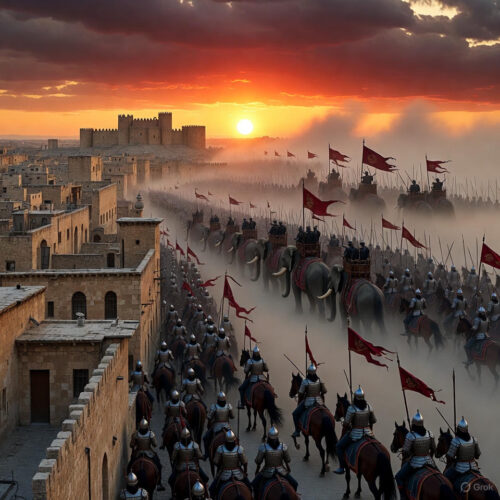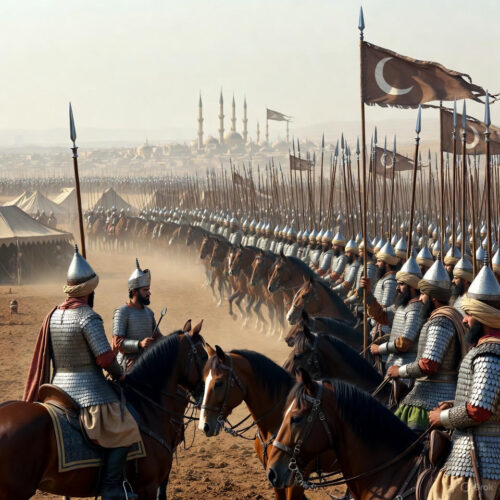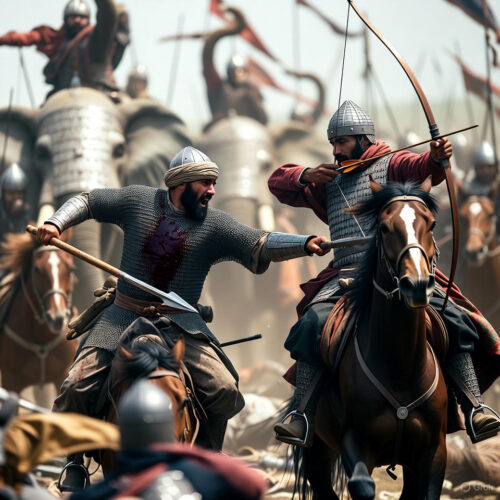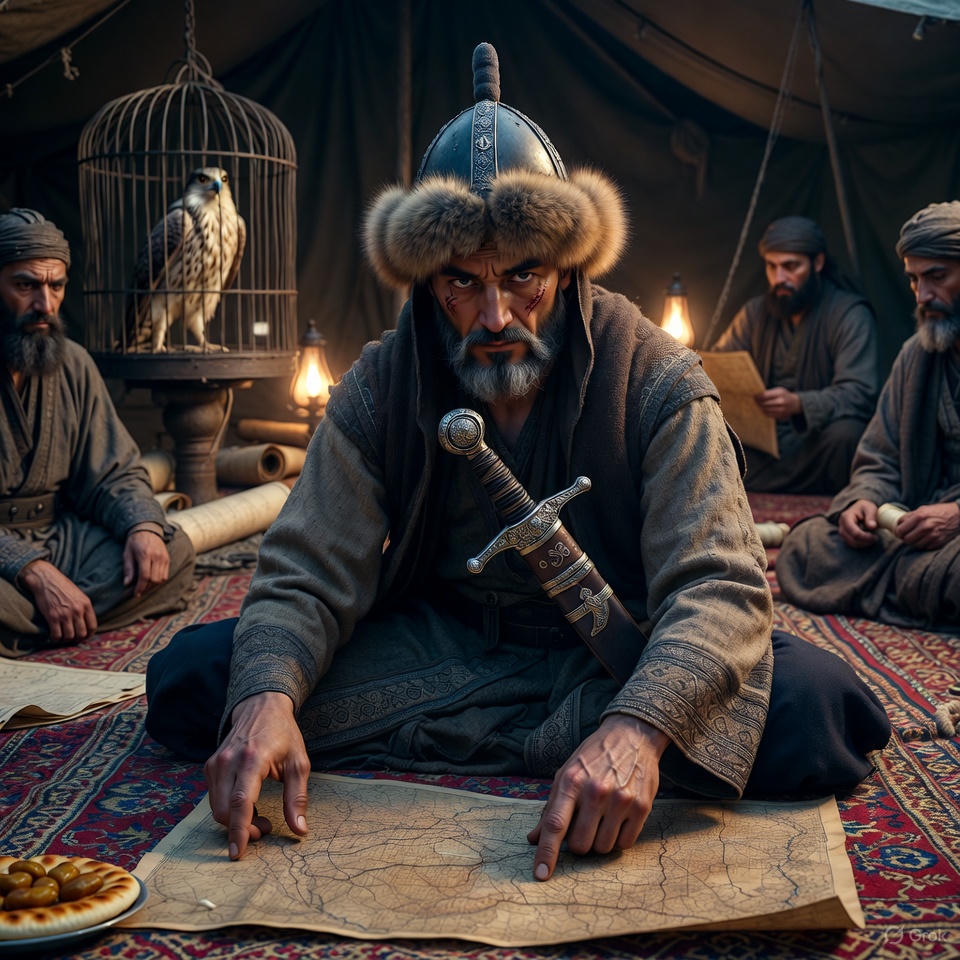November 11, 1400. A date etched into the scorched sands of Syrian history not with ink, but with the blood of thousands and the stark silhouette of a macabre monument—a pyramid of human skulls rising like a grotesque obelisk against the autumn sky. On this crisp fall day, the city of Aleppo, a glittering jewel on the ancient Silk Road, trembled under the thunder of hooves and the war cries of an unstoppable force. Timur, the lame conqueror known to the world as Tamerlane, unleashed his fury upon its walls, turning a thriving metropolis into a charnel house of screams and smoke. This wasn’t just a battle; it was a meticulously orchestrated apocalypse, a clash of empires that reshaped the Middle East and sent ripples through centuries of power struggles.
Imagine the scene: the air thick with the dust of 200,000 Timurid warriors—hardened steppe nomads, Persian sappers, and even lumbering Indian war elephants—encircling a city that had stood defiant for millennia. Aleppo, with its labyrinthine souks, towering minarets, and citadel perched like a watchful eagle, was no stranger to sieges. But Timur? He was no ordinary marauder. Born a cripple in the windswept plains of Transoxiana, he clawed his way to godlike status through sheer cunning, leaving pyramids of bones from Delhi to Baghdad as his calling cards. On November 11, the Mamluk defenders, elite slave-soldiers forged in the fires of Cairo’s barracks, charged forth in a desperate bid for glory. What followed was a rout so swift and savage that chroniclers would later liken it to “a razor slicing through hair” or “locusts devouring a green field.” By dusk, the skull pyramid loomed as Timur’s signature: 20,000 heads stacked in grim precision, a warning to any who dared defy the lame lion of the steppes.
But why does this dusty chapter from 625 years ago matter to us today? In an era of boardroom battles and personal crossroads, Timur’s triumph wasn’t born of brute force alone—it was a masterclass in audacious strategy, unyielding adaptability, and the raw power of psychological dominance. The outcome? A temporary shattering of the Mamluk Sultanate, the humbling of a superpower, and the birth of an empire that influenced everything from Ottoman borders to Renaissance art (via stolen treasures). Yet, amid the horror, survivors rebuilt, traders rerouted, and lessons in resilience endured. This blog dives deep into the historical maelstrom—far more than a motivational pep talk—unearthing the gritty details of Timur’s world. We’ll trek through his rise, the Mamluks’ might, the battle’s brutal ballet, and the sack’s shuddering savagery. Then, we’ll bridge the chasm to now: how you can channel that same calculated ferocity into conquering your own “Aleppian” sieges—be it a career stall or a life pivot—with bullet-point precision and a step-by-step battle plan. Buckle up; history’s wild ride awaits, equal parts enlightening epic and adrenaline-fueled adventure.

## The Lame Lion’s Roar: Timur’s Forging in the Fires of Transoxiana
To grasp the Sack of Aleppo, we must first wander the rugged steppes where Timur was born—not as a king, but as a bandit with a limp. Around 1336, in the dusty village of Kesh (modern Shahrisabz, Uzbekistan), Timur entered a world of feuding Turkic-Mongol tribes, where survival meant raiding caravans and outwitting rivals. A youthful arrow wound left him with a gimp leg—earning the moniker “Timur the Lame” or “Tamerlane” from Persian tongues twisting “Timur-e Lang.” Far from emasculating him, this scar fueled a compensatory rage, transforming a petty chieftain into a conqueror whose name would echo like thunder across Eurasia.
Timur’s ascent was a chess game played with swords. By his twenties, he allied with the Barlas tribe, a Mongol remnant clinging to Genghis Khan’s shadow. Genghis was his idol; Timur claimed descent from the great khan (a dubious boast, but who dared question?) and aped his tactics: lightning raids, terror as policy, and a code of loyalty enforced by rivers of blood. In 1360, he seized control of Balkh, then methodically devoured Transoxiana, quelling revolts with mass executions—once burying 100,000 prisoners alive in a single trench near Isfahan. His army? A nomadic marvel: 10,000-man tumans of horse-archers who could loose arrows while galloping at full tilt, supported by Chinese engineers hurling Greek fire and Persian siege masters toppling walls with counterweight trebuchets.
By the 1380s, Timur’s gaze turned westward. He sacked Herat in 1381, reducing its libraries to ash in a fit of cultural vandalism that makes modern book-burners look amateur. Persia fell next: in 1387, at the Battle of Anjudan, he annihilated the Muzaffarid dynasty, stacking their skulls into minarets. His 1393 campaign against the Kartids of Herat was a masterstroke of deception—feigning retreat to lure foes into ambushes, then drowning survivors in the Oxus River. India beckoned in 1398: crossing the Indus with 100,000 men, Timur stormed Delhi, slaughtering 100,000 civilians in reprisal for resistance. He looted the Sultanate’s treasures—diamonds, gold, and elephants—leaving the city a ghost town for months. “I am the scourge of God,” he reportedly proclaimed, blending Mongol bravado with Islamic fatalism.
Yet Timur was no mindless brute. A Sunni Muslim with Shi’i leanings, he patronized scholars in Samarkand, building the Bibi-Khanym Mosque with Indian marble and Persian tiles. His court buzzed with astronomers charting stars and poets reciting epics. But beneath the refinement lurked a paranoia: he blinded his son Jahangir for suspected disloyalty and executed artisans who “failed” to match his visions. By 1400, at 64, Timur was a paradox—a cultured destroyer whose empire stretched from the Volga to the Ganges, fueled by 500,000 troops and a logistics train of 50,000 camels. His motivation for Syria? A toxic brew: the execution of his Damascus ambassador by Mamluk viceroy Mintash in 1399, plus a hunger to humble the “infidel” Mamluks who dared claim caliphal legitimacy. As his warriors wearied from Indian jungles, Timur overrode their grumbles: “The Mamluks are but ants before my boot.” Little did they know, Aleppo would test that boot’s mettle.
This era’s backdrop was the post-Mongol shatterzone: the Ilkhanate’s collapse in 1335 left a vacuum filled by Mamluks in the west and Timurids in the east. Trade boomed along the Silk Road—spices from India, silks from China, slaves from the Caucasus—but so did proxy wars. Timur’s invasions weren’t random; they targeted chokepoints like Aleppo, whose bazaars handled a third of the world’s pepper. His 1400 campaign began in spring: ravaging Georgia’s vineyards and Armenia’s monasteries, then besieging Sivas (Sebaste) in July. There, he flayed the garrison alive, draping their skins over walls—a grisly overture to Syria. By October, his host—swollen with Georgian conscripts and Indian beasts—encamped 20 miles from Aleppo, their campfires a starry sea on the horizon.

## The Citadel of Slaves: Aleppo and the Mamluk Colossus
Aleppo wasn’t just a dot on the map; it was the throbbing heart of the Levant, a crossroads where East met West in a cacophony of haggling merchants and clanging anvils. Founded around 2000 BCE by Amorites, it had weathered Hittites, Assyrians, Alexander the Great, and Saladin’s crusader-slaying hordes. By 1400, under Mamluk rule, it boasted 100,000 souls: soap-makers churning olive-scented bars for export, weavers spinning Damascus silks, and armorers forging chainmail that gleamed like fish scales. The Great Mosque, with its honeycombed minaret, called the faithful to prayer five times daily, while the citadel—a 1,000-foot hill fortress—loomed over aqueducts feeding terraced gardens. Caravans from Baghdad brought dates; from Venice, glass beads. Aleppo’s wealth? Equivalent to a modern city’s GDP, funneled through its 12 gates and vaulted khans (inns).
The Mamluks who guarded this bounty were history’s ultimate underdogs-turned-overlords. Born as chattel—often Circassian boys kidnapped from the Black Sea—they were bought, castrated (in some cases), and drilled into super-soldiers in Cairo’s Citadel. By 1250, these “slave kings” had toppled the Ayyubids, defeating Mongols at Ain Jalut in 1260 with composite bows and cataphract charges. Sultan Baybars, a Kipchak Turk, expanded their realm from Nubia to Anatolia, allying with Crusader remnants against common foes. Under Qalawun and his son al-Ashraf Khalil, they captured Acre in 1291, ending two centuries of Latin kingdoms.
By 1400, the Burji Mamluks—Circassian-focused—ruled from Cairo, with Sultan An-Nasir Faraj (r. 1399–1412) a 19-year-old puppet in regent Mintash’s strings. Faraj was no warrior; chronicles paint him as a dilettante fond of falcons and furtive pleasures. Yet the Mamluk army was formidable: 30,000-35,000 cavalry, trained in the qabaq (tent-pegging) that honed lance skills, backed by Bedouin auxiliaries and Arab irregulars. Their iqta’ system—land grants for service—ensured loyalty, while Cairo’s arsenal churned out Greek fire pots and mangonels. Aleppo’s governor, Tamardash al-Nasiri, commanded 10,000 locals, bolstered by emirs like Al-Mu’ayyad Shaykh (Tripoli’s regent, a future sultan) and Altunbuga al-Osmani (Baalbek’s enforcer).
But cracks showed. Internal feuds simmered: Mintash’s 1399 coup against the previous sultan had spilled blood in Cairo, and Faraj’s youth invited plots. When Timur’s envoy arrived in Damascus demanding fealty, viceroy Mintash beheaded him—a fatal blunder igniting the storm. Faraj summoned troops from as far as Gaza, but logistics lagged; reinforcements trickled in, leaving Aleppo’s field army at half-strength. Scouts reported Timur’s approach: after torching Sivas (flaying 4,000 defenders), he’d razed Malatya and Aintab, leaving charnel fields. On October 24 (Islamic 5 Rabi’ I 803 AH), Timur’s vanguard crested the hills, their elephants trumpeting like doomsday horns. Aleppo’s bells tolled; families barricaded homes with date-palm trunks.
The lead-up was a tense pas de deux. Timur, ever the fox, built ditched camps nightly, his pioneers digging moats under moonlight. Skirmishers probed: Mamluk archers felled dozens of scouts, but Timur’s tumans wheeled away, feigning weakness. Inside Aleppo, panic brewed—hoarders jacked grain prices, while ulema (clerics) preached jihad. Tamardash, possibly bribed (as whispers suggest), urged open battle over siege defense. On November 9, Mamluk emirs—İzzeddin Özdemir, his son Uzbek Yasbek, and Sudun of Damascus—rode out to a plain south of the city, 30,000 strong in lamellar hauberks and spiked helms. Timur, with 140,000 (chronicles vary wildly), arrayed opposite: wings of horse-archers, center stiffened by 60 elephants from Delhi, their tusks capped in iron. Reserves lurked—a tuman of 10,000 fresh riders for the kill.

## The Razor’s Edge: Tactics and Carnage on the Field of Bones
November 11 dawned with a chill wind whipping the acacias, carrying the scent of horse sweat and oiled bows. The plain of Halab—flat as a drumskin, ringed by low hills—set the stage for slaughter. Mamluks formed a classic crescent: center of heavy lancers under Tamardash, wings of javelin-throwers and Bedouin skirmishers. Their plan? Hammer the Timurid center, shatter the elephants, then wheel to envelop. Trumpets blared; 30,000 hooves churned dust as they advanced, shields locked, chanting “Allahu Akbar!” like a rolling thunder.
Timur watched from a rise, swathed in black sable, his lame leg propped on a stool. “Let them come,” he growled to Miran Shah, his hot-headed son commanding the right. The Timurids held: center a wall of elephants, mahouts goading the beasts with iron hooks, their howdahs bristling with crossbowmen. Flanks curved outward in vast arcs—20,000 archers per wing, bows drawn to the ear. As Mamluks closed to 200 yards, arrows darkened the sky: a storm of bodkin points punching through mail, felling horses in sprays of foam and blood. Özdemir’s vanguard reeled but pressed, lances splintering on elephant hides, swords hacking at legs. One beast trumpeted in agony, trampling its own lines before collapsing in a crimson heap.
Chaos erupted. Al-Mu’ayyad Shaykh, the Tripoli lion, led a gallant charge, his mace caving Timurid skulls, slaying hundreds before arrows feathered his mail. “For the Sultan!” he roared, but flanks buckled as Timur’s arcs closed like jaws. Feigned retreats lured Mamluks deeper; then, the encirclement: horsemen wheeling inward, loosing parthian shots over rumps. Uzbek Yasbek, Özdemir’s cub, fought like a dervish—his blade a blur, felling two dozen foes—but encirclement doomed him. Surrounded, father and son stood back-to-back, hewing limbs until arrows silenced them. Tamardash’s center shattered; elephants, maddened by javelins, charged wildly, goring friend and foe alike.
The rout was biblical. Mamluks fled pell-mell for Aleppo’s gates, a mile distant. Timur unleashed his reserve tuman: 10,000 fresh wolves on spent sheep. Arab chronicler Ibn Taghribirdi later wrote, “Timur went over them like a razor over hair, running like locusts over green crop.” Lances skewered backs; scimitars hacked necks mid-stride. At the gates, a choke of bodies piled three deep—20,000 corpses by dusk, per exaggerated tallies, though 10,000 seems likelier. Survivors battered the portals; archers atop walls loosed futile volleys. The battle? Less than an hour from charge to collapse. Timur lost perhaps 2,000—light for such asymmetry—his elephants unscathed, mahouts plying them with wine-soaked rags.
Eyewitnesses painted vivid horrors. Persian poet Hafiz-i Abru, embedded with Timur, noted the “sea of blood” staining the plain, where vultures wheeled early. Mamluk survivor accounts, smuggled to Cairo, decried Tamardash’s “treachery”—had he truly taken Timur’s gold? The field became a scavenger’s feast: looters stripping rings from stiff fingers, dogs worrying entrails under a setting sun. Timur, surveying the carnage, ordered surgeons to tend his lame leg, then dispatched sappers to the walls. Aleppo’s fall was imminent; resistance crumbled like dry clay.

## Flames and Skulls: The Sack That Scarred a Civilization
Surrender came swift—November 2 by some calendars, but the true sack raged from the 11th onward, a four-day inferno eclipsing the battle’s brevity. Gates flung open, Timur’s hordes poured in: Mongol ulaghs (vanguard looters) first, then tumans proper. Streets ran red; the Great Mosque, sanctuary for 5,000 women and children, became a abattoir. Chronicles shudder: soldiers herded families inside, barring doors, then torched the mihrab. Flames licked frescoes as screams pierced the smoke; survivors clawed at walls, nails splintering on marble.
Atrocities defied humanity’s frail code. In side chapels, “gentlewomen and virgins” endured public defilement—stripped, bound with prayer-rug ropes, passed among squads like spoils. Fathers and brothers, chained to columns, watched helplessly as daughters wailed under the onslaught. Ibn Arabshah, a Damascus refugee who fled to Timur’s court (only to defect), penned the rawest account: “Naked they remained through the assaults, their modesty a tattered veil.” Children? Spared no mercy—bayoneted or trampled, their tiny forms heaped in alleys. The stench? A miasma of rot and char, lingering weeks, as unburied dead bloated under November rains.
Timur orchestrated the terror with cold artistry. Captives marched before him: Tamardash in irons, Sudun of Damascus whimpering oaths, Altunbuga Osmani stripped to rags. “You slew my envoy,” Timur spat, ordering floggings in the citadel square. Sheikh Ali al-Hasiki, Aleppo’s imam, pled for mercy, citing Quranic verses on compassion; Timur, feigning piety, spared the mosque’s books but not its people. Outside, engineers piled skulls: 20,000 Mamluk heads, sorted by rank—emirs at the base, peasants atop—forming a 50-foot ziggurat visible for miles. “Let the wind whisper my name,” Timur quipped to Shah Rukh, his pious son who averted eyes from the gore.
Plunder was systematic: souks gutted, gold melted in campfires, silks bundled for Samarkand harems. Elephants, laden with ivory-inlaid chests, trumpeted through gates; one chronicler tallied 1,000 camels of loot. Fires crowned the spree—libraries torched, though some ulema smuggled scrolls to the citadel. Casualties? Aleppo halved: 50,000 dead or fled, per Ibn Taghribirdi, leaving a husk of 50,000 ghosts. Sufi mystic Abd al-Rahman al-Bistami called it “heresies and horrors,” Timur’s “golden fields” turned to ash. Yet, in the rubble, flickers of defiance: hidden cellars where scribes copied histories, vowing vengeance.
The sack’s psychology was Timur’s genius. Not mere vengeance, but vaccination against revolt—fear as firewall. Mamluk regents, paraded in chains, bought uneasy truces; Faraj, quaking in Cairo, sent tribute caravans. Timur, sated, turned south: Hama fell in days, its citadel razed; Homs and Baalbek yielded without fight, emirs kissing boots. Damascus, the prize, besieged in December: Faraj arrived with 15,000 but fled at first clash, claiming “rival plots” in Egypt. The city surrendered; Timur spared it briefly, then sacked it too—massacring 100,000, per hype, in a week of orgiastic ruin.

## Ripples in the Rubble: Aftermath and the Empire’s Ebbing Tide
Timur’s Syrian sortie ended in January 1401, his legions laden with spoils wending back to Samarqand. Damascus’s sack capped the campaign: libraries burned (including the Umayyad Mosque’s treasures), but Timur hosted a “victory feast” for scholars, a hypocritical flourish. Faraj’s flight exposed Mamluk frailty; Mintash seized Cairo in coup, only to be beheaded by the boy-sultan. Al-Mu’ayyad Shaykh, Timur’s prisoner, escaped en route east, returning to claim the throne in 1412—a phoenix from ashes.
Long-term? The Mamluks staggered but endured till 1517, when Ottomans eclipsed them at Marj Dabiq. Aleppo rebuilt slowly: by 1420, souks hummed again, though scars lingered—fewer Christians, wary traders. Timur’s terror tactics influenced successors: Ottomans adopted skull pyramids in Balkans; Safavids in Persia echoed his mobility. Economically, Silk Road detours boosted Tabriz; culturally, refugee scholars fled to Italy, seeding Renaissance humanism with Arabic texts. Demographically, Syria’s population dipped 20%, per estimates, fueling nomadic influxes.
Timur himself? The conqueror limped on: invading Ottoman Anatolia in 1402, capturing Bayezid I at Ankara—chaining him in a cage like a trophy lion. But hubris bit: in 1405, eyeing China, he died en route at Otrar, racked by fever at 68. His empire fractured—sons like Shah Rukh ruled fractiously—yet his DNA lingers in Uzbek lore and Tajik epics. The skull tower? Eroded by time, but its shadow looms in histories from Clavijo’s Spanish embassy tales to Marlowe’s “Tamburlaine” plays, where the lame tyrant roars immortal lines.
## From Skull Piles to Summit Climbs: Harvesting Timur’s Triumph for Your Battlefield
Now, the pivot: amid this tapestry of terror, what outcome gleams for modern mortals? Timur’s victory stemmed not from savagery alone, but strategic audacity—overriding fatigue, flanking foes psychologically, rebuilding from ruins. The Mamluks fell to disunity; survivors rose through adaptability. You? Facing job losses, relationships in rout, or dreams deferred? Channel Timur’s calculated boldness: turn “lame” setbacks into levers of leverage. Not conquest, but conquest of self—ruthless in resolve, merciful in mercy. Here’s how, in laser-focused bullets, then a battle-tested plan.
– **Master Encirclement Thinking**: Timur’s arcs trapped enemies; in life, surround challenges with multi-angle attacks. Facing a promotion block? Flank via skill-building (online certs), networking (LinkedIn coffees), and mentors (cold-email experts)—no linear charge, but a web that strangles stagnation.
– **Weaponize Psychological Pyramids**: His skull tower broke wills pre-battle; build your “monument” of micro-wins. Track daily victories in a journal— a closed deal, a gym PR—stacking them visually (app or wall chart) to intimidate doubt, turning fear into fuel for marathons like career pivots.
– **Adapt Like a Steppe Nomad**: Timur’s tumans wheeled on whims; you, pivot fluidly. Lost your gig? Raid “new pastures”—freelance on Upwork, upskill in AI via Coursera, relocate for opportunity. Rigidity killed Mamluks; your mobility slays inertia.
– **Forge Alliances from Adversity**: Captives like Shaykh became sultans; transform rivals into allies. Post-breakup? Co-parent with grace, turning ex into network node. In business, negotiate with “foes” over mergers—Timur’s truces yielded tribute; yours, collaborations yielding windfalls.
– **Rebuild with Ruthless Prioritization**: Aleppo rose from ash by focusing essentials; post-crisis, audit life ruthlessly. Cut toxic ties (energy vampires), invest in high-ROI habits (reading 20 mins daily), and erect “citadels” like emergency funds—ensuring no sack leaves you gutted.
**Your 5-Step Aleppo Assault Plan: Conquer Any Siege in 90 Days**
- **Scout the Plains (Days 1-7)**: Map your “Aleppo”—define the threat (e.g., debt mountain) with brutal honesty. Journal: What’s the Timur (core fear)? Gather intel—books like “The 48 Laws of Power,” podcasts on strategy. Build your “camp”: daily 10-min meditation for clarity.
- **Assemble the Tuman (Days 8-30)**: Rally resources—10 “horsemen” (habits/actions): e.g., network weekly, learn one skill biweekly. Enlist “elephants” (big bets): enroll in a course, pitch a side hustle. Test flanks: small experiments, like emailing 5 contacts.
- **Charge and Encircle (Days 31-60)**: Launch the assault—execute with Timur’s speed. Track progress weekly; if resistance (doubt), feint retreat (rest day) then counter. Measure kills: quantifiable wins, like $ saved or connections made.
- **Sack and Secure (Days 61-80)**: Harvest gains—celebrate the “loot” (rewards: trip for milestone). Neutralize remnants: forgive past failures, build buffers (savings, skills). Erect your pyramid: visualize achievements to ward future foes.
- **March to Damascus (Days 81-90+)**: Consolidate—reflect in a “victory chronicle.” Pivot south: scale wins (promote side hustle to full-time). Repeat annually; Timur’s empire endured through iteration—yours, through relentless evolution.
There you have it: one of history’s unvarnished grinds, laced with the thrill of what-ifs and the spark of “you can too.” Timur’s Aleppo wasn’t destiny’s dice; it was deliberate dominance. What’s your plain today? Charge it—lame leg or no.

